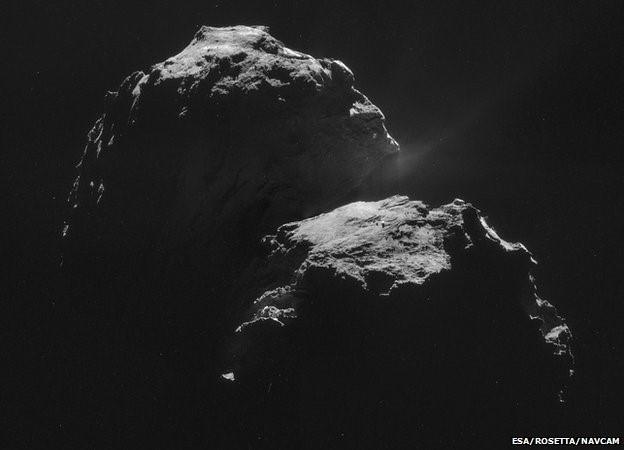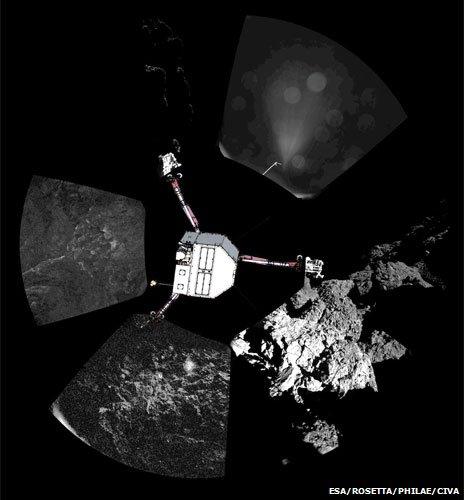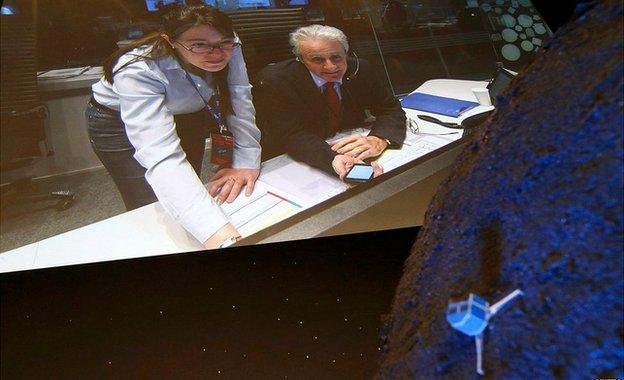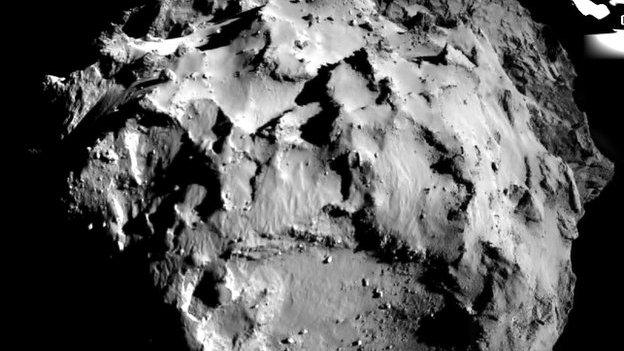Comet landing: Where next for Philae mission?
- Published

Landing safely on this was never going to be easy
The big day has been and gone.
Little Philae bounced to a stop on the surface of an ancient wanderer and fell into a slumber.
So where does that leave this audacious European mission?
Philae's touchdown on 67P/Churyumov-Gerasimenko was the first soft landing by a manmade object on a comet.
European Space Agency officials made clear before the attempt that nothing about landing on this irregular-shaped object was guaranteed.
Its terrain is marked by deep basins and imposing cliffs, but even relatively flat surfaces contain boulders and fractures that could spell doom for a spacecraft.
So scientists had constructed a programme of data collection - the so-called First Science Sequence - designed with a worst-case scenario in mind.
Each instrument on the lander was to get a turn at collecting science data from the comet within the 60 hours of life afforded by the onboard batteries.
As it became clear that Philae had come to rest in the shadow of a cliff, preventing sunlight from reaching its solar panels, the plan was put into action.
At the weekend, Dr Stephan Ulamec, the lander manager, confirmed that Philae had been able to transmit all the science data gathered during the First Science Sequence.
And Prof Mark McCaughrean, Esa's senior scientific adviser, added: "All of the science instruments on board have done all the work they were supposed to do, so we have huge amounts of data back on the ground now."

Pictures of Philae's descent on 12 November are helping locate the little craft
It remains unclear whether all of these tasks scheduled for the instruments were executed successfully.
But scientists are currently sifting through the data returned from the comet's surface and will report results in due course.
So what can we expect from the measurements gathered during Philae's final hours before entering its deep sleep?
Both the Civa and Rolis cameras on Philae have returned images taken during the descent to the comet and from its surface.
We also know that the MUPUS instrument attempted to hammer into the surface to use its sensors to gauge the comet's temperature. But underneath some "fluffy" material, was some very hard stuff indeed.
MUPUS scientists tried each of the hammer's three power settings - and after failing to penetrate the surface using those, proceeded to a "secret" fourth setting. This setting, nicknamed "desperate mode", broke the hammer.
Nevertheless, the exercise suggests the surface of the comet may have a tensile strength approaching that of sandstone.
That in itself may be a significant scientific discovery, because it's a far cry from the softer consistency some have envisaged for these "dirty snowballs" - thought to be relics from the formation of the Solar System.
While we had thought asteroids were largely rocky or metallic and comets predominantly icy, recent research suggests the division is fuzzier than first thought.

Several images have been taken on different sides of the lander, illustrated here with the pictures arrayed around a diagram of the probe

The mission has generated immense excitement among the public
That hard surface might also explain why Philae bounced so high - maybe a kilometre up - after its initial landing.
One of the key objectives of the mission, come what may, was to drill the surface to obtain a sample of "soil" for analysis.
As Philae's battery power waned, it was feared there might be only one opportunity to drill, so scientists had to choose one of the two gas analysers on Philae to give the sample to.
They opted for the German-built COSAC instrument, which was designed to identify carbon-based (organic) compounds and analyse volatile compounds - water, carbon dioxide and others - in the surface. This might shed light on the chemical package delivered to Earth early on in its history, when it was being bombarded by such objects regularly.
COSAC was favoured over sending the sample to the British-led Ptolemy instrument, as the latter was considered more energy intensive than its German counterpart. It remains unclear whether all the stages in this task were completed successfully.
Nevertheless, COSAC was able to "sniff" the comet's thin atmosphere for organics; analysis of the results is ongoing.
Ptolemy is designed to detect different forms of light elements such as carbon, hydrogen and oxygen. This could shed light on the relationship between these relic bodies and the planets in our Solar System.
For example, it could help answer whether comets originated during the same events that spawned Earth, or whether they record a history that stretches back much further.

The Rosetta orbiter will continue to gather data for about a year
There is a chance that Philae will wake up again when the comet nears the Sun, and light once again reaches the lander's solar arrays. This might allow scientists to collect even more data from the surface. But as with everything on this ambitious mission, nothing is guaranteed.
Advocates of space exploration will argue that the mission has been a roaring success. And in many ways it has.
But it was not an unqualified one. The systems designed to tack the lander to the comet failed - including the vital harpoons. If those had worked, Philae might be in a very different situation to the one it finds itself in today.
It must, however, be remembered that the brilliant scientists and engineers who worked on this mission were pushing the boundaries of exploration.
The dangers associated with landing meant that most scientific capital was invested in the orbiter - Rosetta. This will continue to orbit and observe 67P for at least a further year.
The mission has helped demystify these icy bodies, so long a symbol of disaster and misfortune to the ancients.
It has also taken the first steps towards unravelling the true nature of these cosmic nomads, and in so doing will probe fundamental questions about the origins of our planet and the life that thrives upon it.
Follow Paul on Twitter, external.
- Published17 November 2014

- Published15 November 2014

- Published15 November 2014
- Published13 November 2014
